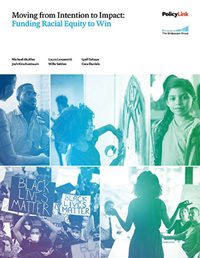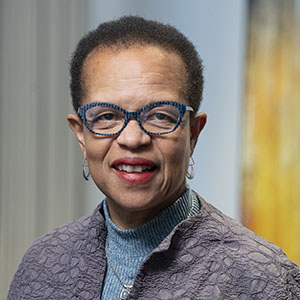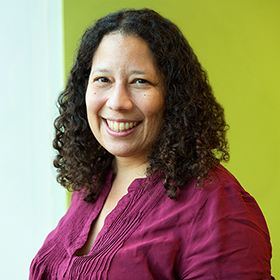Executive Summary
 In order to transform the lives of the more than 100 million people1 in America living in or near poverty—or 1 in 3 people, including nearly half of the people of color in the nation2—we need fundamental shifts in our culture, policies, programs, and institutions.
In order to transform the lives of the more than 100 million people1 in America living in or near poverty—or 1 in 3 people, including nearly half of the people of color in the nation2—we need fundamental shifts in our culture, policies, programs, and institutions.
To achieve those systemic changes without racial disparities will require a well-capitalized movement for equity that is aligned around a common set of values and desired results.
PolicyLink has teamed up with The Bridgespan Group to analyze the state of philanthropic funding for racial equity work; our focus in this piece is on large dollar donors (inclusive of both institutional philanthropy and individuals). Informed by the expertise of movement leaders on the frontlines of this work, we share what we’ve learned about funders’ intentions to contribute toward racial equity, and what it will take to move from intention to enduring impact. We also offer specific ways that funders can close the gap and we frame what level of funding is needed.
Download the Executive Summary
Download the Full Report
This report reinforces messages by equity leaders working toward structural change like those behind the California Black Freedom Fund and the open letter from the Groundswell Fund co-signed by more than 400 funders. Although these developments, among others, are important signs of momentum, we also observe a growing resistance to racial equity in some parts of the sector and the nation that further highlights that now is a critical time to bolster the case for a robust, sustainable movement for racial equity fueled by doers and donors.
The State of Philanthropic Funding for Racial Equity
Philanthropic intention to fund racial equity surged significantly in 2020. However, how much actual giving has happened is hard to definitively pinpoint. That is because the vast majority of the money publicly pledged for racial equity work in 2020 has not been reported beyond foundation website statements, news articles, and corporate press releases. In fact, 94 percent of past racial equity funders have not reported their 2020 data yet, as of early June 2021.3 Therefore, we don’t actually know whether the checks are in the mail—or not—or who might be getting them.
A key beginning step in closing the intention gap is to report data to Candid quickly and transparently. Funders should share how much of their funding is going to racial equity work—including how much is going to structural or systems-change efforts, to organizations led by people of color and in multiyear general support. For philanthropy to hold itself accountable to making progress toward an equitable nation, it is critical to know how much is being invested and what type of work the money is funding.
Based on currently reported grant data collected by Candid, $1.5 billion in funding for racial equity in 2020 can be tracked to recipients. That is a small fraction of the $11.9 billion that was publicly pledged for racial equity.4
However, discussions with leaders across the equity ecosystem raised three concerns about the surge of 2020 racial equity funding, fueled by what they know so far and past experience:
- The money may not have gone to the full range of work that is needed to support transformative change. Without a more intentional focus on directing funding toward work that disrupts the root causes of inequity, there’s a risk that any amount of money would be insufficient to eliminate the nation’s racial disparities and improve outcomes for all of the 100 million people living in poverty in the United States. We saw evidence that while philanthropy has shown up to fund efforts at key moments—efforts aimed around a specific campaign cycle or policy change—funding to do the critical long-term work that endures beyond those moments, including narrative change and long-term organizing, is much harder to come by.
- The money is insufficient to address the historic undercapitalization. Research has shown that the majority of organizations doing racial equity work are undercapitalized. These organizations tend to be led by people of color and/or focused on systems change, two categories that funders have traditionally given less support.5 In our examination of 2018 funding, the most recent year complete data is available, we found the majority of racial equity grants were relatively modest with the median grant size at $50,000. More than 64 percent of the nonprofits received $100,000 or less.
- The money will disappear. Mindful of philanthropy’s history of relative limited giving to racial equity, concerns run high that 2020 was an anomaly with interest in racial equity energized by a perfect storm of nationwide outrage over state-sanctioned murders and a global pandemic, a combination that hopefully will not be replicated. To ensure giving is sustained will require a transformation of philanthropic norms, practices, and culture.
What We Need: A Robust, Sustainable Movement Fueled by Doers and Donors
Funders striving to help achieve equity will need to consider both what they fund as well as how they fund. There are also on-ramps to this work for every type of funder, including issue-based funders, place-based funders, community foundations, family foundations, and corporate philanthropy. Finally, there are practical steps for funders to take that would collectively add up to major shifts in the way philanthropy supports movements for racial equity. (Please see our “Practical Steps Funders Can Take” guide.)
Funders should recognize that there is persistent activity that is in opposition to equity that will only be overcome through sustained, durable support. Movement leaders reinforced that there is always some kind of opposition to nearly every aspect of equity work, which philanthropists who seek to advance equity should both anticipate and prepare for. That includes anticipating that there will be backlash, setbacks, and progress that comes in fits and starts. Preparing for this will require investing longer with flexible funding and measuring impact differently.
“It’s really up to funders to sit back and hold the tension around one step forward and three steps back. Part of that step back is if the work is not well resourced,” says Elena Conley, chief strategy officer for the Mary Reynolds Babcock Foundation, a longtime funder of grassroots groups in Georgia and the South.
The National Committee for Responsive Philanthropy (NCRP) “Power Moves” guide encourages funders to see that the path to equity and justice is dependent on the building, sharing, and wielding of power. “Power Moves” defines building power as “supporting systemic change by funding civic engagement, advocacy, and community organization among marginalized communities.”6 Philanthropists often shy away from funding power-building efforts as too partisan. But funders committed to racial equity would be better served to view any and all efforts through an equity lens rather than a political one: will such action help or hinder efforts to achieve racial equity? At any given moment, both parties are proposing reforms to policy, tax, government regulations, judicial appointments, etc. at the local, state, and federal levels that may ultimately stall equity or create inequity.
“Good grantmaking for racial equity has to also involve great policy and advocacy if you want it to be as effective and sustainable as we hope it can be,” says Darrin Goss, senior CEO of the Coastal Community Foundation in South Carolina. Cheryl Dorsey, CEO of Echoing Green,7 encourages funders to take a broader view for the sake of equity, “Funders are terrified of the word ‘advocacy’ but, in essence, advocacy is raising your hand and talking about what you care about.”
What Will It Take to Win on Equity?
"I would love to see every metropolitan area or region have a $1 billion pledge in the bank that resources a generation of community-controlled systems level changes"
While changing the nation to become more equitable is possible, quantifying just how much that will truly cost is difficult today. What we do know is that any effort that is not deliberately trying to advance equity builds on existing institutions that are reinforcing today’s status quo of inequity or, worse, that are exacerbating it. Such inertia is always going to be cheaper than the investment in re-imagination might initially require.
And, ultimately, the price we pay for our inequity is always going to cost us the most. “Philanthropy’s accountability has to go beyond that we fund good organizations to do good work but instead to philanthropy actually seeing themselves as a part of the ecosystem,” says organizer LaTosha Brown of Black Voters Matter. “We are funding this work because there is a vested interest for all of us to eliminate structural racism and create a nation that is more inclusive and equitable.”






